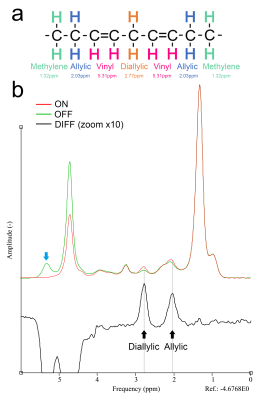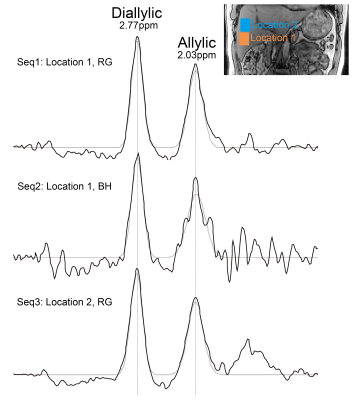4362
In-vivo measurement of hepatic unsaturated lipid using J-difference-edited MRS.1College of Biomedical Engineering & Instrument Science, Zhejiang University, Hangzhou, China, 2MR Collaboration, Siemens healthineers ltd., Shanghai, China, 3Department of Endocrine, Sir Run Run Shaw Hospital, Hangzhou, China
Synopsis
Measurement of lipid composition in liver is of high importance. The J-difference-edited MRS allows detection of low-level overlapped metabolites, including hepatic unsaturated lipid. This study was to investigate the efficacy of J-editing on human hepatic unsaturated lipid, with different experimental setup. Multiple potential influencing factors such as breath control and voxel localization were parallelly compared. In-vivo hepatic MRS data was acquired in three healthy subjects. The statistical analysis of experimental variance and test re-test reliability demonstrates that MEGA-PRESS with respiratory-gating at lower level in liver allows consistent and robust in-vivo measurement of different human hepatic unsaturated lipid molecules.
Introduction
Hepatic lipid accumulation results in hepatic steatosis, fibrosis and non-alcoholic steatohepatitis1. Compared to saturated fatty acids, mono-unsaturated fatty acids and poly-unsaturated fatty acids are reported to be potentially protective against oxidative stress2 but also could be the biomarkers for malignant changes3. 1H-MRS has been extensively used in hepatic lipid measurements in vivo4, yet unsaturated lipid has been poorly understood in vivo due to its low abundance and overlapping signals with other metabolites5. J-difference-edited (JDE) MRS allows detection of different characteristic groups of unsaturated lipid protons. JDE-MRS is generally more demanding on experimental conditions, and is particularly hard in liver owing to serious motion in abdominal region6-8. This study aimed to investigate and demonstrate the influence of breath-control and voxel localization on hepatic unsaturated lipid measurement using JDE-MRS on 3T clinical systems. The coefficient of variation (C.V) and the intra-class correlation coefficient (ICC) were calculated to assess measurement stability and test-retest reliability.Methods
Instrument: Experiments were conducted on Siemens MAGNETOM Prisma 3T MRI scanners using 18-channel body coils.In-vivo Experiment Setup: Three healthy subjects (2 males and 1 female; 22-24 years-old) were recruited. JDE experiments were performed at TE of 45 ms using MEGA-PRESS sequence. The scan parameters included: TR = 2000 ms; spectral width = 2 kHz; voxel size = 25*40*40 mm3; 128 transients (respiratory-gating, RG) / 8 transients (breath-holding, BH) and 2048 datapoints. The edited-pulse bandwidth was 115 Hz and the edited frequency was 5.31 ppm (editing off at 7.5 ppm). The shimming and frequency adjustment were performed during BH of 20 s. All BH operations were carried out at the end of exhalation. All participants were examined 3 times with reposition. Each exam included 3 edited-MRS scans with 2 different voxel localization and 2 different breath-control methods (RG vs. BH).
Data Processing: Automatic spectral registration was performed with the FID-A toolbox using the methyl and bulk methylene signal as the landmark. The transients corrupted by motion artifacts were discarded automatic thresholding (about 85% data was reserved for future analysis). A L2-regularization-based approach was used to remove water residual and glycerol groups9. AMARES (jMRUI-v6) algorithm was used to quantify allylic and diallylic signals. The peak amplitude was quantified and normalized by spectral noises.
Statistical Analysis: The C.V across different exams and one-way random-effects multiple measurements ICC were calculated to assess the measurement stability and test-retest reliability.
Results
Figure 1 demonstrated the successful detection of unsaturated lipid protons in liver. The J-coupling between vinyl and allylic or diallylic protons was edited by applying the soft pulse at 5.31 ppm. The allylic and diallylic peaks were clearly resolved in the difference spectra at 2.03 ppm and 2.77 ppm, respectively. The comparison between two different breath-control methods and two voxel localization was revealed by three scans shown in Figure 2. All three scans can successfully detect both allylic and diallylic peaks while MRS voxel placed at location1 with RG achieved the best signal-to-noise ratio. The summary of the C.V values of all three scans across test-retest exams was presented in Table 1.Table 2 displays the test re-test reliability of measurements on allylic and diallylic signals using ICC. Again, MRS voxel placed at location1 with RG has the highest ICC for both allylic (0.967) and diallylic (0.989) measurements, followed by MRS voxel at location2 with RG (allylic: 0.931, diallylic: 0.952). MRS location at lower level of liver showed better measurement reliability. BH largely limited the duration of acquisition hence it provides lower SNR of unsaturated lipid signals and poorer measurement reliability.
Discussion
A previous study has successfully applied JDE-MRS to quantify lipid composition in human skeletal muscle at TE of 70 ms10. To our knowledge, none JDE-MRS experiments in human liver have been reported. During JDE-MRS acquisition, motion in hepatic region causes frequency drift, magnetic field inhomogeneity and location error that would result in the failure of J-difference editing. In this work, J-difference editing in liver has been performed and the unsaturated lipid signal of allylic and diallylic groups have been clearly resolved and quantified. To address the influencing factors that affect the reliability of unsaturated lipid quantification, different breath-control methods and MRS voxel localization have been tested and compared. The results showed lower levels in liver had higher spectral quality and measurement outcome, which could be derived from the larger distance from lung/heart. RG is also more preferable than BH, which allows more freedom in data acquisition and longer scan time with higher spectral SNR. In our other study, we also verified that the optimal TE for J-editing of unsaturated lipid signal is 45 ms using both simulations and phantom/in-vivo experiments. In this study, 45 ms was accepted as the optimal TE for JDE experiment. We also have compared it to TE of 70 ms, which gave a much lower allylic peak.Conclusion
MEGA-PRESS was successfully performed in liver to resolve the allylic and diallylic signals from unsaturated lipid. MRS voxel localized at lower region of liver and respiratory-gating would improve the reliability in measurement which allows the calculation of detailed lipid composition in liver. This new approach provides opportunities to in vivo investigations of metabolic pathways related to many important liver diseases.Acknowledgements
No acknowledgement found.References
1. Saponaro C, Gaggini M, Carli F, Gastaldelli A. The Subtle Balance between Lipolysis and Lipogenesis: A Critical Point in Metabolic Homeostasis. Nutrients 2015;7(11):9453-9474.
2. Kremmyda LS, Tvrzicka E, Stankova B, Zak A. Fatty Acids as Biocompounds: Their Role in Human Metabolism, Health and Disease - a Review. Part 2: Fatty Acid Physiological Roles and Applications in Human Health and Disease. Biomed Pap 2011;155(3):195-218.
3. Munir R, Lisec J, Swinnen JV, Zaidi N. Lipid metabolism in cancer cells under metabolic stress. Brit J Cancer 2019;120(12):1090-1098.
4. Sharma P, Martin DR, Pineda N, Xu Q, Vos M, Anania F, Hu XP. Quantitative Analysis of T2-Correction in Single-Voxel Magnetic Resonance Spectroscopy of Hepatic Lipid Fraction. Journal of Magnetic Resonance Imaging 2009;29(3):629-635.
5. Burian M, Hajek M, Sedivy P, Mikova I, Trunecka P, Dezortova M. Lipid Profile and Hepatic Fat Content Measured by H-1 MR Spectroscopy in Patients before and after Liver Transplantation. Metabolites 2021;11(9).
6. Choi IY, Andronesi OC, Barker P, Bogner W, Edden RAE, Kaiser LG, Lee P, Marjanska M, Terpstra M, de Graaf RA. Spectral editing in H-1 magnetic resonance spectroscopy: Experts' consensus recommendations. Nmr in Biomedicine 2021;34(5).
7. Andronesi OC, Bhattacharyya PK, Bogner W, Choi IY, Hess AT, Lee P, Meintjes EM, Tisdall MD, Zaitzev M, van der Kouwe A. Motion correction methods for MRS: experts' consensus recommendations. Nmr in Biomedicine 2021;34(5).
8. Juchem C, Cudalbu C, de Graaf RA, Gruetter R, Henning A, Hetherington HP, Boer VO. B(0)shimming for in vivo magnetic resonance spectroscopy: Experts' consensus recommendations. Nmr in Biomedicine 2021;34(5).
9. Lin LJ, Povazan M, Berrington A, Chen Z, Barker PB. Water removal in MR spectroscopic imaging with L2 regularization. Magnetic Resonance in Medicine 2019;82(4):1278-1287.
10. Lindeboom L, de Graaf RA. Measurement of lipid composition in human skeletal muscle and adipose tissue with (1) H-MRS homonuclear spectral editing. Magn Reson Med 2018;79(2):619-627.
Figures



